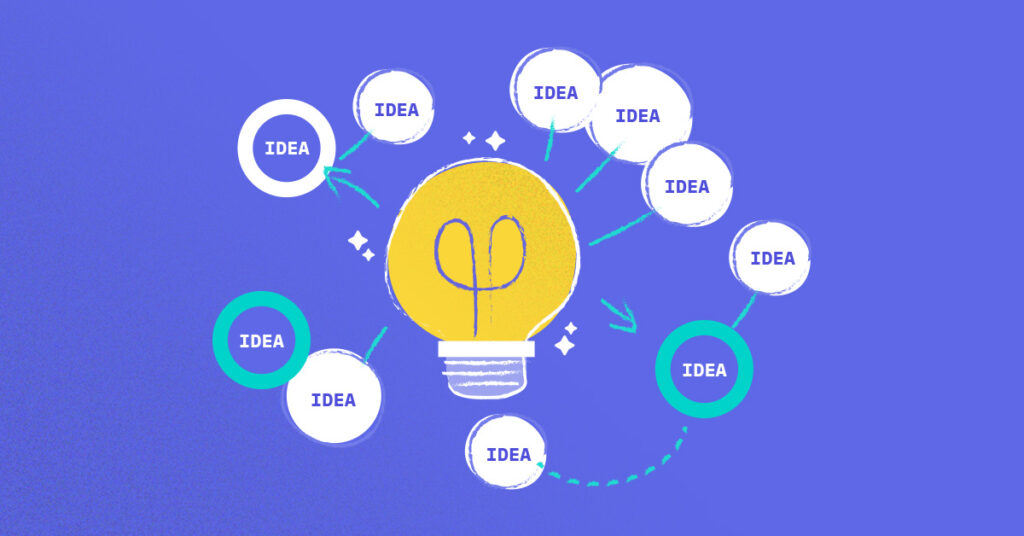Current Brainstorming Process is Broken: How to Generate Ideas More Effectively

Brainstorming is somewhat synonymous with creativity. Some people even equate the entirety of creative thinking with the brainstorming process. Unfortunately, this loose association about brainstorming is also the reason why so many teams are not taking full advantage of it.
I remember my first couple of brainstorming sessions. Thrown into a room with other creatives and instructed to generate a brilliant idea on the spot. That was the expectation. After all, that’s what a brainstorm is for, right?
Through my own struggles and with the lack of direction in those generic brainstorms, I intuitively started adjusting my own approach.
Many, many sessions and later, I found that treating the brainstorming process as a generic idea generation tactic without the proper preparation wastes a lot of time and energy and yields pretty poor results.
My new brainstorming process changed everything for me.
What is Brainstorming, Really?
Brainstorming is a minor component of the creative thinking process. It’s a formal setting that encourages the use of creative thinking.
The primary benefit of a brainstorm is to provide cross stimulation of ideas. To be most effective, it should be framed as a formal setting with defined constraints, so that all participants are aware of the expected outcomes of the session.
With the more thought out brainstorming sessions there can be rules to streamline the process.
You might have heard of encouraging crazy ideas, and only saying ‘yes, and…’ instead of ‘no’. Generate as many ideas as possible. Defer judgement. Some of these techniques, a lot of which are still used in brainstorming today were initially proposed by an advertising executive in the 50s. All of these techniques supposedly encourage a breadth of ideas to come forward.
However, several studies indicate that teams that use these typical rules of brainstorming come up with less quantity and quality of ideas, as compared to teams implementing an individual idea generation process first.
What is Wrong With The Typical Brainstorming Process?
In my many years wasting time and energy in these generic brainstorm sessions, I’ve recognised several issues with this approach. Luckily, later I was given the opportunity to restructure and improve the process.
Here are the key disadvantages, that affect most brainstorming teams:
- Typically brainstorming and idea generation sessions are organised directly or shortly after a briefing and new project kick-off. And even with the breadth of the knowledge between the participating members, at best this knowledge is limited to each person’s current experience and understanding of the matter at hand. I found that in a lot of cases the ideas brought to the team in these instances are based on stereotypes and surface-level knowledge.
- Adopting a ‘yes, and…’ mentality is really useful in a brainstorm. In theory. In reality though, besides using words, people tend to communicate in a non-verbal form. So even when your teammates might be verbally supporting your idea, but their arms are crossed – this tends to discourage even the most confident idea generators.
- Not everyone generates ideas most effectively in a group. Some people are able to generate ideas on the fly, yelling out ideas in a brainstorm, sometimes without much research or background about a particular topic. While others need time and space with the topic, to let the ideas foster.
- When people work together, especially when they have been working together for a long time, their ideas tend to converge. Groups start to engage in ‘groupthink’ – starting to think in the same way and agree with each other to avoid conflict.
7 Tips to Make The Brainstorming Process Effective Again
Here are the key aspects I identified over the years for a more effective brainstorm session:
1. Define the problem clearly
Make sure that a clear problem definition is presented to the team participating, to ensure everyone is solving the same problem.
“If I had an hour to solve a problem I’d spend 55 minutes thinking about the problem and 5 minutes thinking about solutions.”
–Albert Einstein
Formulating the question of the problem clearly plays great significance in how you go about solving that problem.
2. Let everyone generate ideas individually first
Brainstorming should be done only after the individuals have done their research separately and have gone through their own idea generation process.
I personally like to research several sources and gather varying points of view on the topic before I feel I can generate ideas that are relevant.
To me, there’s nothing worse than ideas yelled out in a brainstorm, that lack any deep knowledge.
3. Size does actually matter
If there are too many people in a brainstorm, that usually means that some people don’t get a chance to share. Having too few participants and the meeting becomes an argument. In my experience no less than 3 and no more than 6 participants are ideal.
4. Idea generation in sixty seconds…or rather thirty minutes
Designate a clear time frame for the session. 20 to 30 minutes would usually be sufficient. Avoid running the session longer even if it seems that ideas are still flowing. It’s better to stop while people still have ideas rather than squeeze out every possible idea dry.
To help make sure that ideas remain fresh, you can also insert some external stimuli into the mix. Adding new perspectives into the group can (hopefully) disturb that groupthink.
5. Judge less, contribute more
Yes, this is part of the traditional brainstorming techniques. But this is one that I’ve kept in my brainstorming sessions, to combat everyone’s natural inclination for critical thinking.
In a brainstorm, the ideas should be flowing freely without comments such as ‘what would never work because..” Those comments derail the effectiveness of idea generation and force us to revert to logical thinking rather than creative thinking.
And we want to keep it creative after all.
Just make sure that when you are contributing to the idea, you truly set out with the mindset to build on the idea of the other person. This might help limit your natural furrowed brows syndrome.
The primary aspect of the brainstorm is to share an idea with the group, and someone being able to further add to it, or use it as a springboard to another idea.
6. Take notes – before those ideas dissolve into thin air
Ideas are like a mirage – they can appear and disappear without a trace. To ensure that your brainstorming session is productive and that in the end you actually have some ideas to review, it’s essential to keep track of the ideas.
If possible, a separate person should be assigned to take notes, as to not disturb the natural creative flow of the session.
7. Most importantly, assign an experienced facilitator
Having a strong facilitator can make all the difference if you want to generate innovative ideas.
A facilitator of the brainstorm is perhaps the most important factor for a productive brainstorming session and should be assigned to run the meeting. Without someone steering the direction, brainstorms can spiral out of control.
A great facilitator will know when to allow the team to discuss and flesh out an idea. Will recognise when the team is getting off track. Additionally a leader like that will provide an opportunity for everyone to contribute in an equal way and limit ‘groupthink’.
Bonus: How Might we Exercise
As a bonus suggestion, you can use the ‘How might we’ questions that can help you to look at the problem from a different perspective and find additional ways to innovate. You can use this exercise as part of your individual idea generation step or as part of a team. Watch the YouTube video on that below:
Do You Even Brainstorm?
Do you implement a brainstorming practice in your own business? Or you use it to help solve your clients’ challenges? I want to hear about your experiences with it – reach out via email or on Instagram and let’s get a discussion going!
If you enjoyed reading this article, consider signing up to the Studeo Insider and receive more insights like this one. Know someone who might enjoy this article? Please share it.
